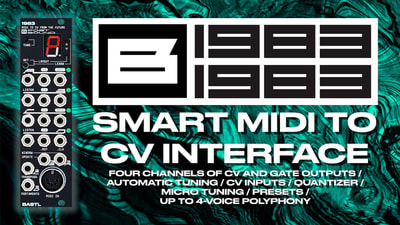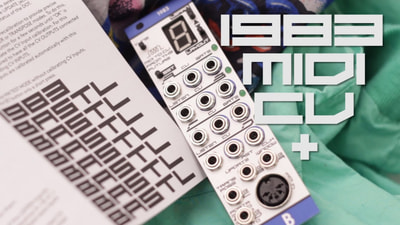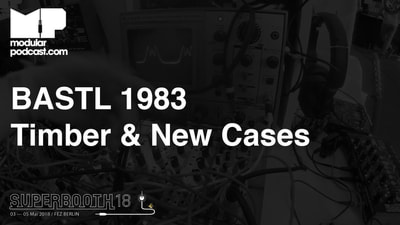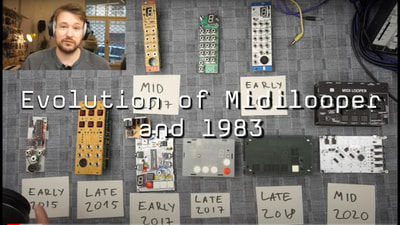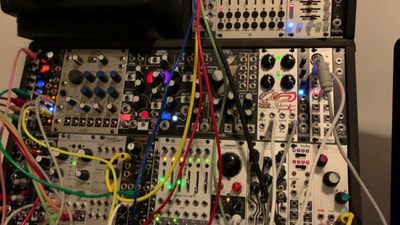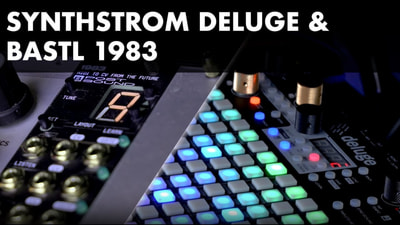1983
Polyphonic MIDI to CV Interface
The 1983 is a polyphonic MIDI to CV interface with creative voice allocation and automatic tuning capabilities.
Everything in tune & responding to MIDI notes correctly
Four channels of CV and GATE outputs can be configured in various Layouts, such as hybrid splits between monophonic and polyphonic voices or velocity, Control Change, aftertouch, triggers, clock or reset.
Automatic tuning
Each channel can LISTEN to simple waveforms from the oscillators, and with a single press of the TUNE button, the 1983 maps the response of each connected oscillator across all seven octaves. This way, it ensures everything is in tune and with each other and that it responds to the MIDI notes correctly ( A4 = 440 Hz, etc.). PURE MAGIC!
CV inputs
The TRANSPOSE jack shifts the outputs by semitones, fifths, or octaves and the PORTAMENTO jack sets the glide time by CV.
The 1983 always stores the notes played in a legato sequence in a buffer, and the WINDOW jack allows for selecting which of these notes appear at the outputs.
When the UPDATE jack is used, it forces the outputs to update only when a trigger is detected.
This way, you can use a MIDI keyboard as an input interface for harmonies and note sets that are further creatively processed with triggers and CV in the modular environment.
Quantizer
The quad Quantizer mode on the 1983 converts input voltages into semitones of scales defined either by playing notes into the MIDI input or by the buttons in the menu. This allows the 1983 to be used tuning correction device (quantizer) without the necessity or using MIDI.
Micro tuning
Default tuning is A = 440Hz in equal temperament, but alternative tuning systems are possible with the µTune feature. It allows working with custom detuning of each semitone in the octave and, therefore, working with just intonation and alternative tuning systems.
Layouts
The 1983 has 4 channels of CV and GATE, and these Outputs can be configured into several different LAYOUTS:
- 4-voice polyphony
- 3-voice polyphony + 1-voice monophony
- 2 monophonic voices with velocity
- 1 complex monophonic voice
- 4 monophonic voices
- 8 gates
- 4 gates with velocity
- 8 CC channels
- 4-channel QUANTIZER
Features
- 4 channels of CV and GATE
- LISTEN input per channel for automatic tuning
- automatic tuning by a single press of a button (offset & scaling correction)
- several tuning systems (equal temperament, just intonation, A = 440/432 Hz, etc.)
- LAYOUT selection (4 voice, 3+1 voice, 2 velocity voice, 4×1 voice, 1 voice, 8 gates, 8 CCs, 4 triggers + velocity, quantizer)
- each layout can map outputs of Channel D to MIDI Clock (adjustable divider) and Reset
- LEARN mode to assign MIDI channel and other properties
- UPDATE jack to quantize outputs to clock or trigger sequences
- WINDOW jack to creatively allocate notes in the buffer to available voices
- TRANSPOSE CV to shift outputs by semitones, fifths, or octaves
- PORTAMENTO CV to adjust glide time
- responds to MIDI Note On & Off, CC (also Sustain), Velocity, Pitch Bend, Clock, Aftertouch
- µTune scale editing per each semitone in octave
Tutorials
1983 - Polyphonic MIDI to CV Mastermind VIDEOMANUAL with Václav
Technical details
- 7 HP
- PTC fuse and diode protected 10 pin power connector
- 24mm deep
- power consumption +12: < 60mA, -12: <20 mA
Downloads
- pdf user manual download
- 日本 (nihon) manual pdf – translated by our friends at Umbrella
- firmware uploader app github
- latest FW update mid zip
- release notes & how to update pdf
Oscillators tested with the 1983 (so far)
- Bastl Tromso, Cinnamon
- Befaco Rampage
- Bubblesound VCOb
- Doepfer A-110-1,A-110-6, A-111-3,
- Epoch Modular Benjolin
- Intellijel Shapeshifter
- Malekko Richter Anti-Oscillator
- Mannequins Mangrove
- Makenoise 0-coast
- Random Source NTO
- Studio Electronics Quadnic
- WMD Spectrum
